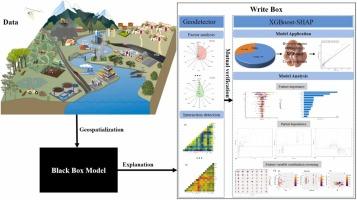当前位置:
X-MOL 学术
›
J. Hazard. Mater.
›
论文详情
Our official English website, www.x-mol.net, welcomes your
feedback! (Note: you will need to create a separate account there.)
Revealing the synergistic spatial effects in soil heavy metal pollution with explainable machine learning models
Journal of Hazardous Materials ( IF 12.2 ) Pub Date : 2024-11-19 , DOI: 10.1016/j.jhazmat.2024.136578 Yibo Yan, Yong Yang
Journal of Hazardous Materials ( IF 12.2 ) Pub Date : 2024-11-19 , DOI: 10.1016/j.jhazmat.2024.136578 Yibo Yan, Yong Yang

|
The identification of factors that affect changes in the heavy metal content of soil is the basis for reducing or preventing soil heavy metal pollution. In this research, 16 environmental factors were selected, and the influences of soil heavy metal spatial distribution factors and the synergy amongst space factors were evaluated using a geographic detector (GD) and the extreme gradient boosting (XGBoost)-Shapley additive explanations (SHAP) model. Three heavy metal elements, namely, Cd, Cu and Pb, in the study region were examined. The following results were obtained. (1) XGBoost demonstrated high accuracy in predicting the spatial distributions of soil heavy metals, with each heavy metal having an R 2 value of over 0.6. (2) Geological type map (Geomap) and enterprise density considerably affected the concentrations of Cd, Cu and Pb in soil in the GD and XGBoost-SHAP models. In addition, cross-detection revealed strong explanatory power when natural and human factors were combined. (3) Under the same geological background, the different trends of gross domestic product effects on heavy metals indicated that pollution control measures were effective in economically developed areas, and the economy and the environment could be balanced. Meanwhile, the interaction between the normalised difference vegetation index and enterprise density showed that vegetation could alleviate heavy metal pollution in the region. This study supports strategic decision-making, serving as a reference for the global management of soil heavy metal contamination, sustainable ecological development and assurance of people’s health and well-being.
中文翻译:

使用可解释的机器学习模型揭示土壤重金属污染中的协同空间效应
识别影响土壤重金属含量变化的因素,是减少或防止土壤重金属污染的基础。本研究选取了 16 个环境因子,采用地理检测器 (GD) 和极端梯度提升 (XGBoost)-Shapley 加法解释 (SHAP) 模型评价了土壤重金属空间分布因子的影响和空间因子之间的协同作用。研究了研究区域中的 3 种重金属元素,即 Cd、Cu 和 Pb。获得以下结果。(1) XGBoost 在预测土壤重金属的空间分布方面表现出很高的准确性,每种重金属的 R2 值都超过 0.6。(2) 地质类型图 (Geomap) 和企业密度对 GD 和 XGBoost-SHAP 模型中土壤中 Cd、Cu 和 Pb 的浓度有很大影响。此外,当自然因素和人为因素相结合时,交叉检测显示出很强的解释力。(3)在相同地质背景下,国内生产总值对重金属影响的不同趋势表明,污染控制措施在经济发达地区是有效的,经济与环境可以取得平衡。同时,归一化差值植被指数与企业密度之间的交互作用表明,植被可以缓解该地区的重金属污染。这项研究支持战略决策,为土壤重金属污染的全球管理、可持续的生态发展和保障人们的健康和福祉提供参考。
更新日期:2024-11-19
中文翻译:

使用可解释的机器学习模型揭示土壤重金属污染中的协同空间效应
识别影响土壤重金属含量变化的因素,是减少或防止土壤重金属污染的基础。本研究选取了 16 个环境因子,采用地理检测器 (GD) 和极端梯度提升 (XGBoost)-Shapley 加法解释 (SHAP) 模型评价了土壤重金属空间分布因子的影响和空间因子之间的协同作用。研究了研究区域中的 3 种重金属元素,即 Cd、Cu 和 Pb。获得以下结果。(1) XGBoost 在预测土壤重金属的空间分布方面表现出很高的准确性,每种重金属的 R2 值都超过 0.6。(2) 地质类型图 (Geomap) 和企业密度对 GD 和 XGBoost-SHAP 模型中土壤中 Cd、Cu 和 Pb 的浓度有很大影响。此外,当自然因素和人为因素相结合时,交叉检测显示出很强的解释力。(3)在相同地质背景下,国内生产总值对重金属影响的不同趋势表明,污染控制措施在经济发达地区是有效的,经济与环境可以取得平衡。同时,归一化差值植被指数与企业密度之间的交互作用表明,植被可以缓解该地区的重金属污染。这项研究支持战略决策,为土壤重金属污染的全球管理、可持续的生态发展和保障人们的健康和福祉提供参考。

































 京公网安备 11010802027423号
京公网安备 11010802027423号